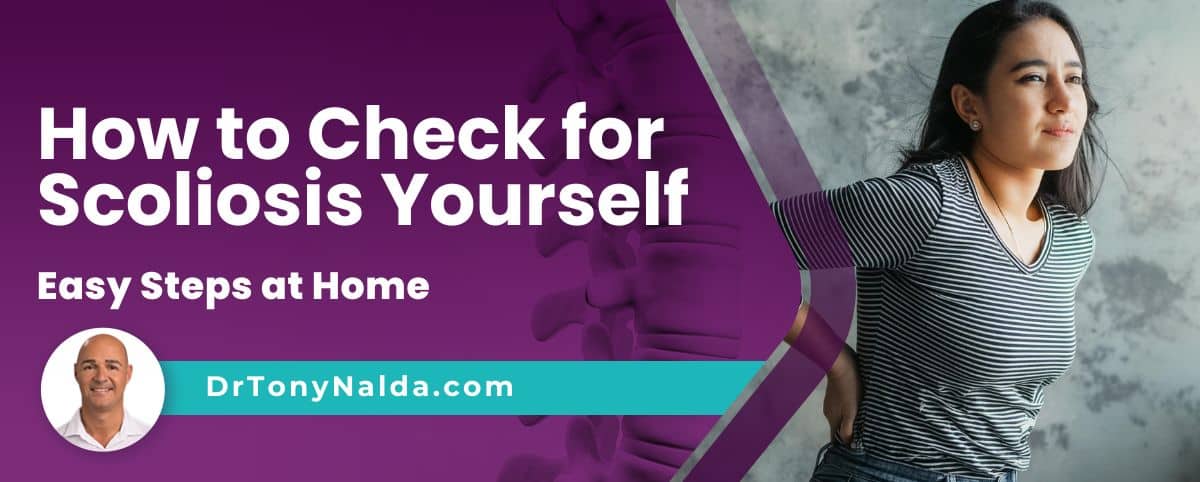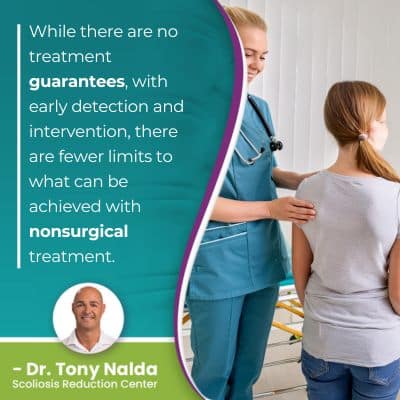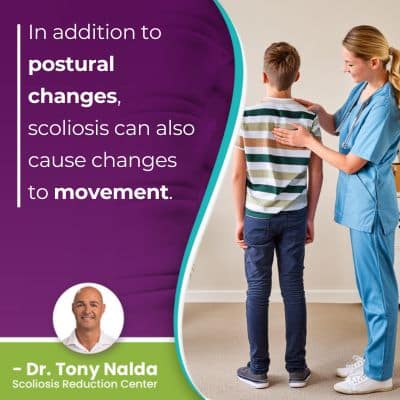How to Check for Scoliosis Yourself: Easy Steps at Home

When it comes to checking for signs of scoliosis at home, for childhood scoliosis, this involves checking for postural changes and disruptions to balance, gait, and/or coordination, and in adults, while postural changes also occur, the condition's most-noticeable symptom is pain: back pain, muscle pain, and/or pain that radiates into the extremities due to nerve compression.
The only way to be officially diagnosed with scoliosis is through a physical examination and scoliosis X-ray conducted by a medical professional. There are, however, signs of the condition that can be checked for at home; this awareness can lead to early detection.
Early detection and intervention is associated with treatment success, and knowing how to check for the early telltale signs of scoliosis can help.
Table of Contents
Understanding Scoliosis
Although scoliosis is a highly-prevalent condition with current estimates of close to seven million people living with scoliosis in the United States alone, there is still a lot we don't understand about the condition.
As the leading spinal condition among school-aged children, mandatory screening used to be conducted by school nurses in the States, but that has since changed, shifting the onus of recognizing the condition early onto the shoulders of parents, caregivers, and patients themselves.
 While there are no treatment guarantees, with early detection and intervention, there are fewer limits to what can be achieved with nonsurgical treatment.
While there are no treatment guarantees, with early detection and intervention, there are fewer limits to what can be achieved with nonsurgical treatment.
Scoliosis is Progressive
In addition, scoliosis is a progressive condition; its nature is to get worse over time.
Scoliosis involves the development of an unnatural sideways curvature of the spine, and the spine also rotates, making the condition 3-dimensional.
As scoliosis progresses, the size of the unnatural spinal curve is increasing, as are the condition's uneven forces, and their effects.
Scoliosis ranges in severity from mild scoliosis to moderate scoliosis, severe and very severe scoliosis.
So as scoliosis progresses, the condition's uneven forces are going to cause postural changes that become more noticeable.
Checking for Scoliosis Effects at Home
No two cases of scoliosis are the same, so effects one patient experiences don't always indicate what others will face.
Scoliosis affects all ages from babies born with the condition as congenital scoliosis, infantile scoliosis, early-onset juvenile scoliosis, adolescent idiopathic scoliosis, and adult scoliosis is diagnosed once skeletal maturity has been reached.
The most common type overall is adolescent idiopathic scoliosis, diagnosed between the ages of 10 and 18.
In most cases of scoliosis, we don't know what caused their initial onset, and this is idiopathic scoliosis that accounts for approximately 80 percent of known cases, and the remaining 20 percent are associated with known causes: neuromuscular scoliosis, congenital scoliosis, and degenerative scoliosis.
Different types and severity levels affect the body differently, and the main effect of scoliosis for children to look for at home are postural changes, and these are caused by the condition's uneven forces disrupting the body's overall symmetry.
There are no treatment guarantees, but with early detection comes early intervention, and this is associated with treatment success.
Smaller curves are simpler to treat, and as the spine gets more rigid as scoliosis progresses, it becomes less responsive to treatment, and while we don't fully understand scoliosis onset, we know it's growth that triggers progression, so childhood scoliosis should always be taken seriously.
Checking for Postural Changes
For parents, caregivers, and patients themselves, it's important to be aware of the condition's early telltale signs so early detection is possible.
When it comes to childhood scoliosis, the most common effect is postural deviation, so changes to look for include:
- The head appearing uncentered over the torso
- An uneven eye line
- Uneven shoulders
- The development of a rib cage arch
- Uneven hips
- Arms and legs that appear to hang at different lengths
- Uneven shoulder blades
As a result of these postural changes, clothing can suddenly seem ill-fitting with necklines pulling to one side, and arms and legs not hanging evenly.
So for parents and/or caregivers, what's the best way to monitor postural changes?
Adam's Forward Bend Test
An adam's forward bend test is a screening examination that is used to check for indicators of scoliosis, and if indicators are present, an X-ray is ordered to fully see what's happening in and around the spine: to determine a patient's Cobb angle measurement and that there is a rotational component.
A patient's Cobb angle measurement determines condition severity, a factor that treatment plans are shaped around.
The more unnaturally curved and twisted the spine is, the more noticeable its effects are likely to be, but particularly in mild cases, even postural changes can be subtle and difficult for an average person to recognize.
Having a child stand up straight and then bend forward at the hips with the spine parallel to the floor and the arms dangling at the sides puts the spine in a highly-visible position; in this position, a bend can sometimes be seen with the naked eye, and postural asymmetries in the trunk are also highly noticeable in this position.
As the spine and trunk can easily be checked at home in this position, this can be a good method for regularly checking a child's spine and posture.
For medical professionals, an adam's forward bend test is combined with the use of a Scoliometer that indicates a patient's angle of trunk rotation (ATR), and while having a single asymmetry doesn't guarantee a diagnosis of scoliosis, gradual postural changes becoming more noticeable with growth can indicate the need for further testing.
As growth triggers progression, the goal is to diagnose childhood scoliosis prior to significant progression already occurring, and recognizing the condition's early signs can help.
In addition to postural changes, scoliosis can also cause changes to movement.
Checking for Movement Changes
 As scoliosis disrupts the body's overall symmetry, changes to movement can also occur.
As scoliosis disrupts the body's overall symmetry, changes to movement can also occur.
In most cases, the area of the body located the closest to the affected spinal section is going to feel the majority of the condition's direct effects.
Scoliosis can develop in any of the spine's main sections: cervical spine, thoracic spine, and the lumbar spine.
As the condition causes the body's center of gravity to shift, changes to coordination, balance, and gait are also common.
Scoliosis is an asymmetrical condition, so asymmetrical movement is a common effect.
Scoliosis Pain
Pain is a condition effect that no one wants to experience, but it does serve a purpose: it indicates something is wrong inside the body and can lead to assessment, testing, and diagnoses.
For children, scoliosis pain isn't common so is more so considered an indicator for adult scoliosis.
Scoliosis doesn't become a compressive condition until skeletal maturity has been reached, and it's compression of the spine and its surrounding muscles and nerves that causes the majority of condition-related pain.
Scoliosis pain can involve muscle pain, back pain, and pain that radiates into the extremities due to nerve compression, and it's pain felt in the arms and legs that is the main effect that brings adults in to see me for a diagnosis and treatment.
In young patients whose spines are still growing, the constant lengthening motion counteracts the compressive force of the unnatural spinal curve, and this is barrier to early detection of childhood scoliosis, but scoliosis pain is the main effect of adult scoliosis to check for at home.
Adults also experience postural changes and a noticeable lean to one side, but it's pain that it's the most noticeable condition effect.
Conclusion
The only way to definitively know whether a person has scoliosis or not is to receive an assessment and diagnosis from a medical professional, and this will involve a physical examination, examining the patient's spine in a forward bend position, and the results of a scoliosis X-ray.
What can be checked for at home, however, are signs of scoliosis as this can lead to early detection and intervention.
The benefits of diagnosing scoliosis early in the condition's progressive line include being able to start treatment while curves are smaller and more flexible, so they will be more responsive to treatment.
As the effects of scoliosis increase alongside progression, it's more effective to proactively work towards preventing progression and increasing condition effects, than it is to attempt to reverse effects once they've developed.
Here at the Scoliosis Reduction Center, my patients benefit from a proactive conservative treatment approach that's started as close to the time of diagnosis as possible, and scoliosis treatments are integrative and combine chiropractic care, physical therapy, scoliosis exercises, corrective exercises, corrective bracing, and rehabilitation.
While scoliosis isn't considered a genetic condition, it is considered familial, so if there is a family history of the condition, scoliosis screenings should be performed regularly, and proactive treatment that addresses the underlying structural nature of scoliosis is the best way to minimize and manage symptoms.
Dr. Tony Nalda
DOCTOR OF CHIROPRACTIC
After receiving an undergraduate degree in psychology and his Doctorate of Chiropractic from Life University, Dr. Nalda settled in Celebration, Florida and proceeded to build one of Central Florida’s most successful chiropractic clinics.
His experience with patients suffering from scoliosis, and the confusion and frustration they faced, led him to seek a specialty in scoliosis care. In 2006 he completed his Intensive Care Certification from CLEAR Institute, a leading scoliosis educational and certification center.
About Dr. Tony Nalda
 Ready to explore scoliosis treatment? Contact Us Now
Ready to explore scoliosis treatment? Contact Us Now





